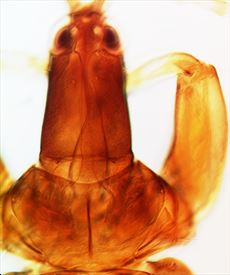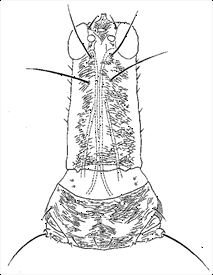Distinguishing features
Both sexes fully winged. Body dark brown; fore tarsi and distal two thirds of tibiae yellow; antennae brown, with segment III yellow in distal third, IV and V with a band of yellow near base, and VI with pedicel yellow; major setae pale; fore wings brown. Head elongate, about 3 times as long as median width; dorsal surface finely sculptured; ocelli well developed; compound eyes large, slightly smaller ventrally than dorsally; postocular setae exceptionally long; a second pair of long setae on vertex; paired postocellar and preocellar setae smaller; maxillary stylets retracted into head as far as eyes; maxillary guides stout. Antennae 7-segmented; III elongate, about 4 times as long as apical width; III and IV each with 2 long, curved sense cones. Pronotum finely sculptured; setae short, except epimerals; epimeral sutures complete; basantra absent. Mesopresternum broadly boat-shaped. Metanotum elongate, striate laterally, faintly reticulate medially; sternopleural sutures present. Fore tarsal tooth blunt, arising near apex of tarsus. Fore wings parallel sided, with 40–56 duplicated cilia. Pelta with median lobe elongate, lateral lobes slender and transversely elongate; tergite II finely sculptured, with lateral margins eroded and posteroangular setae absent; wing-retaining setae on tergites II–VI; posteromarginal setae on tergite IX about half as long as tube; tube exceptionally long, covered with small, sharply pointed setae except basally and near constricted apex; terminal setae short.
Male similar to female, but pronotal midlateral setae long; fore tarsal tooth large, pointed.
Related species
Only one species is known in this genus. Endemic to New Zealand, it is closely related to Heptathrips, the species of which have similar stout maxillary guides. However, the tube is unlike that of any other species in the tribe Pygothripini in bearing numerous distinct lateral setae.
Biological data
Feeding on fungal spores, possibly in dead, hollow twigs, but associated with both native and adventive-dominated habitats.
Distribution data
Known only from New Zealand, where it has been collected widely (ND, AK, BP, WI, WN / SD, NN, MC).
Family name
PHLAEOTHRIPIDAE, IDOLOTHRIPINAE
Species name
Cleistothrips idolothripoides Bagnall
Original name and synonyms
Cleistothrips idolothripoides Bagnall, 1932: 512
References
Mound LA & Palmer JM (1983) The generic and tribal classification of spore-feeding Thysanoptera (Phlaeothripidae: Idolothripinae). Bulletin of the British Museum (Natural History). Entomology 46: 1–174.
Mound LA & Walker AK (1986) Tubulifera (Insecta: Thysanoptera). Fauna of New Zealand 10: 1–140.




